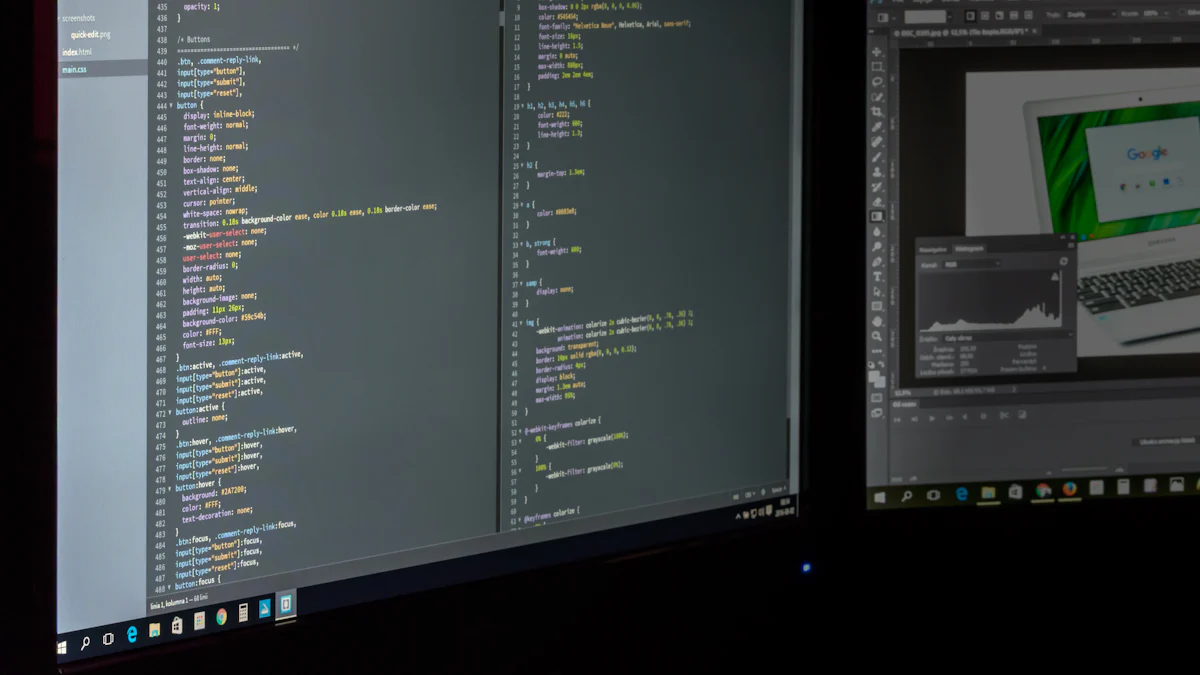How to Effectively Showcase Coding Skills on Your Resume
Try Aihirely for
Smarter Interview Prep
Experience real-time AI support tailored to your Resume.
Boost your confidence and ace every question with
AI Mock Interview.

Image Source: unsplash
When applying for technical roles, your resume needs to do more than list your experience—it should tell a story about your coding expertise. Employers want to see how your skills align with their needs. For example, 1 in 5 IT hiring managers value personal coding projects as much as work experience. Highlighting these projects or certifications can set you apart. With software developer jobs expected to grow by 22% from 2019 to 2029, describing coding on a resume effectively can make all the difference. Show recruiters why you’re the perfect fit.
Key Takeaways
-
Adjust your resume to fit the job description. Focus on needed skills to get noticed by recruiters.
-
Highlight popular coding languages like Python and Java. Show you know current trends to improve your chances.
-
Use strong action words and add numbers to your results. This makes your work stand out and shows your impact clearly.
-
Add links to your GitHub or portfolio. Recruiters can view your projects and see your coding skills directly.
-
Make your resume simple and easy for systems to read. Use basic formatting so it works with tracking software.
Deciding Which Coding Skills to Include

Image Source: unsplash
Analyzing the Job Description
Identifying required and preferred coding skills.
The first step in deciding which coding skills to include is to carefully read the job description. Employers often list specific programming languages, tools, or frameworks they need. Look for keywords like “required” or “preferred” to understand what they value most. For example, if a job asks for Python and SQL, make sure these skills are front and center on your resume.
Pro Tip: Tailoring your resume to match the job description increases your chances of passing applicant tracking systems (ATS) and catching a recruiter’s attention.
Aligning your skills with the job requirements.
Once you’ve identified the key skills, align them with your own expertise. If you’re proficient in Python but only have basic knowledge of Java, focus on Python while mentioning Java as a secondary skill. Highlighting the right skills shows you’re a strong fit for the role.
Selecting Relevant Skills
Prioritizing in-demand programming languages and tools.
Some coding skills are more sought after than others. In 2023, the most in-demand programming languages include:
-
Python (#1 in job postings, #3 in average salary)
-
Java (#2 in job postings, #5 in average salary)
-
JavaScript (#3 in job postings, #4 in average salary)
-
C# (#4 in job postings, #1 in average salary)
-
SQL (#8 in job postings, #8 in average salary)
If you know any of these, prioritize them on your resume. These skills not only make you more marketable but also show you’re keeping up with industry trends.
Avoiding outdated or irrelevant skills.
Avoid listing outdated programming languages like Fortran or Cobol. Similarly, skip basic computing skills like Microsoft Office, as they’re assumed for tech roles. Including irrelevant skills can make your resume look cluttered and outdated.
Note: Using outdated email accounts like AOL or Hotmail can also give the wrong impression. Stick to professional, modern email addresses.
Balancing Skill Breadth and Depth
Highlighting foundational and advanced coding skills.
Employers want to see a mix of foundational and advanced skills. Foundational skills, like understanding algorithms or basic programming concepts, show you have a strong base. Advanced skills, like expertise in machine learning or cloud computing, demonstrate your ability to tackle complex challenges. Balancing both makes your resume more appealing.
Emphasizing expertise in specific areas.
While breadth is important, depth in a particular area can set you apart. For instance, if you’re a Python expert, mention specific frameworks like Django or Flask. If you’ve worked on personal projects or certifications, use them to showcase your expertise. Describing coding on a resume effectively means showing both your range and your mastery.
Structuring Your Resume for Coding Skills
Creating a Technical Skills Section
Listing programming languages, frameworks, and tools.
Your technical skills section is one of the first things recruiters look at. Make it easy for them to find what they need. Start by creating a distinct section with a clear heading like “Skills” or “Core Competencies.” List your programming languages, frameworks, and tools in a simple, easy-to-read format. For example:
-
Python, Java, JavaScript
-
Django, React, Flask
-
Git, Docker, AWS
Keep it concise and relevant. Tailor this section for each job application by researching the company and role. Place the most important skills at the top to grab attention right away.
Grouping skills by category for clarity.
Organizing your skills into categories can make your resume more readable. Group similar skills together, such as “Programming Languages,” “Frameworks,” and “Tools.” This structure helps recruiters quickly understand your expertise. For example:
-
Programming Languages: Python, Java, JavaScript
-
Frameworks: Django, React, Flask
-
Tools: Git, Docker, AWS
This approach shows you’re thoughtful about how you present your abilities.
Integrating Coding Skills into Work Experience
Using action verbs to describe coding achievements.
When describing your coding experience, action verbs are your best friend. Words like “developed,” “implemented,” and “streamlined” make your accomplishments sound dynamic and impactful. For instance:
-
“Developed a Python script to automate data processing, reducing manual effort by 30%.”
-
“Streamlined the deployment process using Docker, cutting deployment time by 50%.”
These verbs help you stand out and show you’re results-driven.
Quantifying results with metrics.
Numbers speak louder than words. Quantify your achievements to show the impact of your work. For example:
-
“Improved system efficiency by 20% through optimized algorithms.”
-
“Reduced crash rates by 15% with debugging expertise.”
-
“Boosted productivity by 25% by automating repetitive tasks.”
A resume without numbers is like a story without proof. Use metrics to back up your claims and make your contributions undeniable.
Highlighting Skills in Other Sections
Including relevant coursework or certifications in education.
Your education section can also highlight your coding skills. Include relevant coursework, like “Data Structures and Algorithms” or “Machine Learning.” If you’ve earned certifications, such as AWS Certified Developer or a coding bootcamp diploma, list them here. These details show you’ve invested in your skill development.
Mentioning coding projects in a dedicated section or summary.
If you’ve worked on coding projects, don’t bury them in your work experience. Create a separate section for “Projects” or mention them in your summary. Include links to your GitHub or portfolio so recruiters can see your work firsthand. For example:
-
“Built a web application using React and Flask, deployed on AWS.”
-
“Developed a machine learning model to predict stock prices with 85% accuracy.”
Highlighting projects shows you’re passionate about coding and have hands-on experience.
Demonstrating Proficiency and Experience

Image Source: pexels
Showcasing Projects
Highlighting personal, academic, or professional coding projects.
Your coding projects are a great way to show what you can do. They give recruiters a clear picture of your skills and creativity. Whether it’s a personal project, something you built in school, or a professional assignment, include it on your resume. Here are some examples of projects you can highlight:
-
Personal Portfolio Website: A great way to showcase your work and skills.
-
Task Management Application: Demonstrates full-stack development skills.
-
E-Commerce Platform: Highlights database management and security features.
-
Blogging Platform: Shows full-stack development capabilities.
-
Chatbot Project: Displays skills in AI and NLP.
-
Mobile App Development: Perfect for showcasing mobile development expertise.
-
Social Media Dashboard: Highlights API usage and real-time data management.
-
Weather Forecasting App: Uses third-party APIs for beginner-to-intermediate skills.
-
Automated Data Scraper: Demonstrates data handling expertise.
These projects not only show your technical skills but also your ability to solve real-world problems.
Including links to GitHub or an online portfolio.
Adding links to your GitHub or online portfolio can make your resume stand out. Recruiters love seeing tangible evidence of your work. It shows you can write and understand code, which is essential for most programming roles. Plus, it highlights your collaboration skills if you’ve worked on team projects. Sharing your portfolio also demonstrates your passion for coding, especially if you’ve contributed to open-source projects. This extra effort can set you apart from other candidates.
Tip: Make sure your GitHub profile is clean and professional. Include detailed README files for your projects to help recruiters understand your work.
Listing Certifications and Training
Mentioning certifications like AWS, Google Cloud, or coding bootcamps.
Certifications can boost your resume by proving you have hands-on experience with specific tools or platforms. Employers highly value certifications like AWS Certified Developer, Google Cloud Professional, or those from coding bootcamps. These credentials show you’ve mastered practical skills that align with job requirements. In fact, 72% of employers consider certifications an important factor when hiring for technical roles.
Including online courses or workshops that demonstrate skill development.
If you’ve taken online courses or attended workshops, don’t forget to list them. Platforms like Coursera, Udemy, or edX offer courses in Python, machine learning, or web development that can strengthen your resume. These courses show you’re committed to learning and staying updated with industry trends.
Highlighting Achievements
Mentioning awards or recognitions for coding expertise.
Awards and recognitions can make your resume shine. If you’ve won a coding competition or received an award for your technical skills, include it. These achievements show you’re not just skilled but also stand out among your peers.
Including hackathon participation or open-source contributions.
Hackathons are a goldmine for showcasing your skills. They prove you can solve problems under pressure and work well in a team. Recruiters love seeing hackathon experience because it highlights your technical and soft skills. Open-source contributions are equally valuable. They show you’re passionate about coding and willing to collaborate with others. Both experiences signal to employers that you’re innovative and adaptable.
Pro Tip: Mention specific hackathons or open-source projects you’ve worked on. For example, “Contributed to an open-source library used by over 10,000 developers” or “Won 2nd place at XYZ Hackathon for developing a real-time chat app.”
Formatting and Tailoring for Impact
Optimizing for ATS
Using keywords from the job description.
Applicant Tracking Systems (ATS) play a huge role in the hiring process. To make sure your resume gets through, use keywords directly from the job description. If the listing mentions “JavaScript frameworks” or “cloud computing,” include those exact phrases in your resume. This helps the ATS recognize you as a match for the role. Don’t overdo it, though—keep the language natural and relevant.
Avoiding complex formatting that ATS may not parse.
ATS can struggle with fancy designs or unusual layouts. Stick to a clean, simple format to avoid issues. Here’s how to make your resume ATS-friendly:
-
Stick to traditional fonts like Arial, Calibri, or Times New Roman.
-
Use black text only to prevent distortion.
-
Stick to a one-column layout to avoid misalignment.
-
Save your resume as a PDF to lock in the formatting.
These tips ensure your resume looks professional and readable, both for ATS and recruiters.
Using Action Verbs and Metrics
Examples of strong action verbs.
Action verbs bring your achievements to life. They show what you’ve done and how you’ve contributed. Here are some great examples for coding roles:
-
Created, Tested, Designed, Deployed, Engineered
-
Strengthened, Resolved, Launched, Analyzed, Enhanced
Using these verbs makes your resume more dynamic and engaging.
Quantifying results to demonstrate impact.
Numbers make your accomplishments stand out. Instead of saying, “Improved system performance,” say, “Improved system performance by 30%.” Quantifying your results shows the real impact of your work. For example:
-
“Automated data entry processes, saving 10 hours per week.”
-
“Reduced website load time by 40% through optimized code.”
-
“Increased user engagement by 25% with a redesigned interface.”
Metrics make your achievements undeniable and help recruiters see your value.
Tailoring for Each Job Application
Customizing the resume for specific roles.
Every job is different, so your resume should be too. Tailor it to highlight the skills and experiences that match the role. Adjust your summary, technical skills, and even your project descriptions to align with the job requirements. As Elizabeth Anderson, a senior tech recruiter, says, “A resume tailored for the role isn’t just a list of your skills, but a thoughtful match between your abilities and what the employer wants.”
Removing irrelevant skills or experiences.
Keep your resume focused. Remove skills or experiences that don’t relate to the job. For example, if you’re applying for a backend developer role, skip mentioning your experience with graphic design. This keeps your resume concise and relevant, making it easier for recruiters to see why you’re a great fit.
Pro Tip: Tailoring your resume shows you’ve done your homework and care about the role. It’s a small effort that can make a big difference.
Effectively describing coding on a resume can make you stand out in a competitive job market. Highlight your projects, quantify your achievements, and showcase the tools and languages you’ve mastered. Tailor your resume for each job to show recruiters you’re the perfect fit. Avoid common mistakes like using a generic resume or overloading it with jargon.
Keep it simple and ATS-friendly. Use traditional fonts, black text, and a clean layout. Incorporate metrics and action verbs to make your accomplishments shine. A well-crafted resume not only gets you noticed but also proves you’re ready to contribute to any team.
By showcasing your practical experience, you demonstrate your ability to thrive in real-world settings and deliver results.
Final Tips:
-
Modify your summary to match the role.
-
Save your resume as a PDF to lock formatting.
FAQ
How many coding skills should I include on my resume?
Focus on quality over quantity. Include 8-12 relevant skills that match the job description. Highlight your strongest programming languages, tools, and frameworks. Avoid listing every skill you’ve ever learned—stick to what’s most relevant for the role.
Should I include beginner-level coding skills?
Only include beginner-level skills if they’re directly relevant to the job. For example, if the role mentions a language you’re learning, list it as “basic knowledge.” Otherwise, focus on skills where you have confidence and practical experience.
Do I need to include links to my GitHub or portfolio?
Yes! Adding links to your GitHub or portfolio lets recruiters see your work in action. It’s a great way to showcase your coding projects, collaboration skills, and problem-solving abilities. Just make sure your profiles are polished and professional.
Can I list coding bootcamps or online courses?
Absolutely! Bootcamps and online courses show your commitment to learning. Include them in your education or certifications section. Mention the specific skills or tools you mastered, like Python, React, or cloud computing.
How do I make my resume stand out to recruiters?
Tailor it for each job. Use action verbs, quantify achievements, and highlight relevant projects. Keep the layout clean and ATS-friendly. Show your passion for coding through personal projects or open-source contributions. Recruiters love seeing real-world impact.
Tip: Proofread your resume carefully. Typos can hurt your chances of landing an interview.
